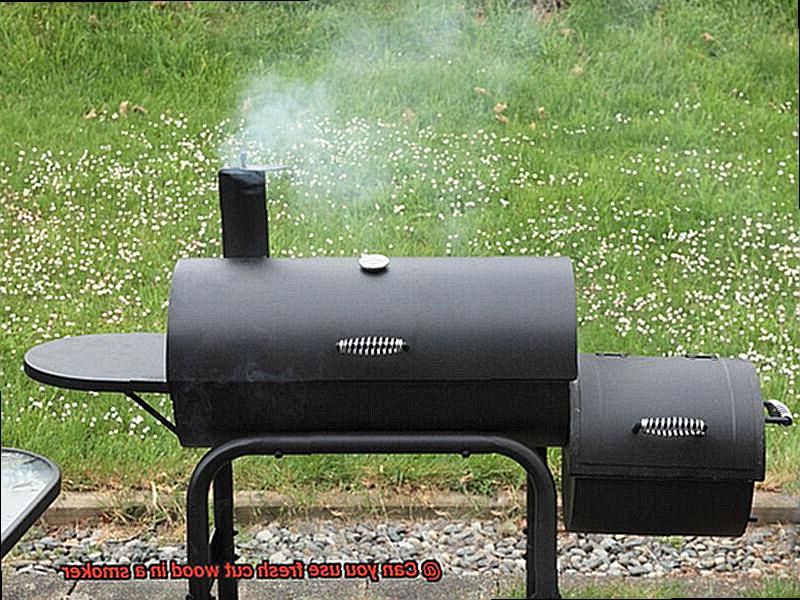The tantalizing aroma of barbeque wafts through the air as outdoor cooking enthusiasts gear up for another season of smoking meat. But before you get too excited and start chopping down trees for fresh cut wood to use in your smoker, there are some things you should know.
Firstly, using fresh cut wood can lead to creosote buildup, which can ruin the flavor of your meat and even pose a health hazard. Additionally, fresh wood can lead to uneven smoking temperatures and cause your meat to cook improperly.
But don’t worry – we’re here to help. In this blog post, we’ll explore the pros and cons of using fresh vs. pre-cut wood for your smoker. We’ll also discuss the best types of fresh wood to use for smoking, so you can achieve that perfect smoky flavor without sacrificing safety or taste.
Whether you’re a seasoned pro or just starting out on your smoking journey, this post will provide all the information you need to make an informed decision about whether fresh cut wood is right for your next BBQ. So sit back, relax, and let’s dive into the world of smoking with fresh cut wood.
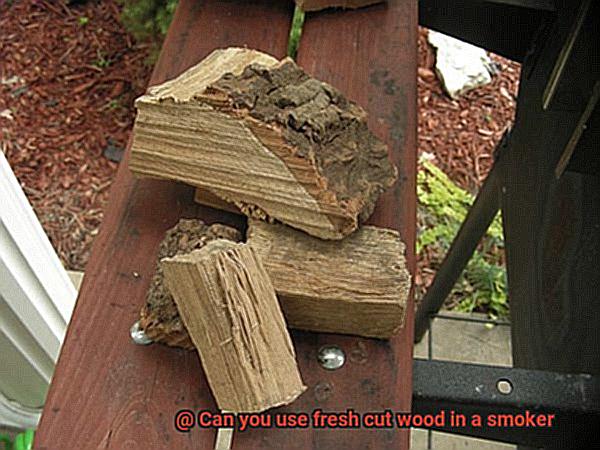
Contents
Pros and Cons of Using Fresh Cut Wood in a Smoker
The decision to use fresh cut wood in your smoker comes with its fair share of pros and cons that you should consider before making a final decision.
One of the most significant advantages of using fresh cut wood is its availability. If you have a backyard or live near a wooded area, obtaining fresh cut wood is easy, and it’s free. Additionally, the unique and intense flavor that fresh cut wood provides to smoked meats is unmatched by store-bought wood chips. As the moisture content in fresh cut wood can produce more smoke, the result is a distinctive and delicious flavor profile that will leave your taste buds satisfied.
Another advantage of using fresh cut wood is its cost-effectiveness. Compared to store-bought wood chips, fresh cut wood is usually less expensive, making it an affordable option for those on a budget.
However, there are also some cons to using fresh cut wood that you should be aware of. One major drawback is its high moisture content, which can cause uneven burning. This creates smoke that’s either too heavy or too light and can damage your smoker or leave an unpleasant taste in your mouth.
Another con of using fresh cut wood is its unpredictable flavor. Each type of wood has its unique flavor profile, making it challenging to know which one will produce the desired results. This requires some trial and error before finding the perfect combination that works for you.
Lastly, using fresh cut wood requires time and effort to season and dry out the wood before use properly. This involves storing the wood in a dry and well-ventilated area for several months to reduce its moisture content. While this extra step can be time-consuming, the result is worth it when you achieve the perfect smoky flavor.
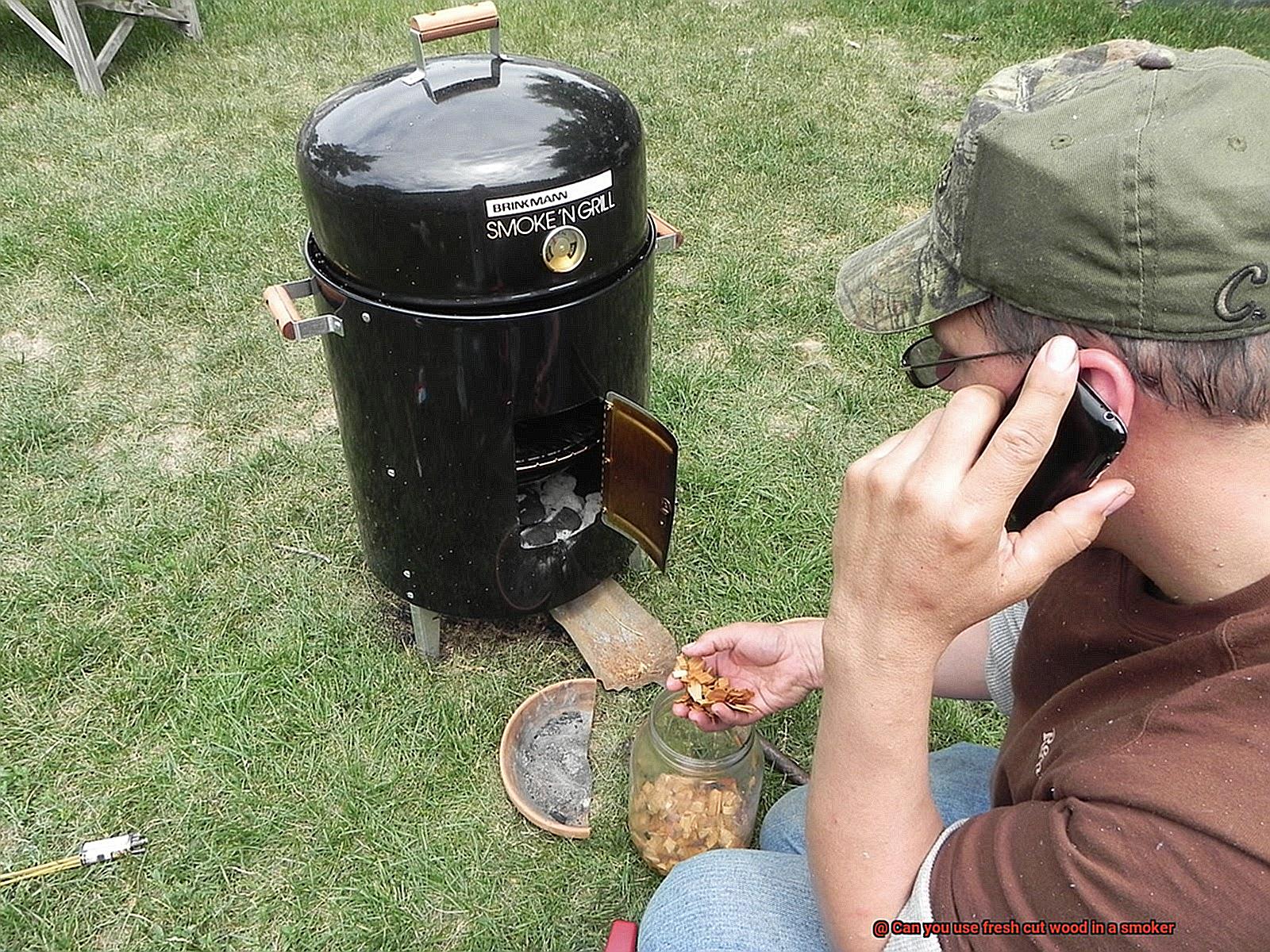
How to Season Fresh Cut Wood for Smoking
Smoking meat is not only a cooking method but also an art form. The flavor and aroma of the meat depend on the kind of wood used in the smoker. If you have fresh cut wood and want to use it for smoking, there are a few steps you need to take to make it suitable.
Splitting the Wood into Smaller Pieces
The first step in seasoning fresh cut wood is to split it into smaller pieces. This increases the surface area of the wood, enabling it to dry out faster. It is recommended to split the wood into pieces that are no larger than 6 inches in diameter. This size is perfect for even drying and suitable for most smokers.
Storing in a Dry and Well-Ventilated Area
Stack the wood in a dry and well-ventilated area. You can store it in a garage or shed with good air circulation. It’s important to keep the wood off the ground and use a cover to protect it from rain or snow. Leave the wood to dry for at least six months. The longer you let it dry, the better quality wood you will have for smoking.
Checking Moisture Content Regularly
During the seasoning process, it is crucial to check the moisture content of the wood regularly. A moisture meter can be used to determine when the wood is ready for smoking. The ideal moisture content for smoking wood is between 10-20%. If the moisture content is too high, the wood will produce uneven burns and bitter flavors.
Kiln Drying

If you don’t have six months to wait, there is another option – kiln drying. This process involves placing fresh cut wood in a special oven that removes moisture quickly. Kiln drying takes only a few days instead of several months but does require specialized equipment and can be costly. However, kiln-dried wood is of high quality and produces consistent smoke.
Using the Seasoned Wood in Your Smoker
Once your wood is seasoned, you’re ready to use it in your smoker. It’s essential to start with a small amount and monitor the smoke closely to make sure it’s not producing any bitter flavors. Remember, the wood should enhance the flavor of the meat and not overpower it.
Dangers of Using Unseasoned Fresh Cut Wood in a Smoker
Before you fire up your smoker, it’s essential to understand the dangers of using unseasoned fresh cut wood. As an expert in this field, I will guide you through the risks and explain why it’s crucial to use properly seasoned wood.
Unseasoned or green wood contains a high moisture content, which can cause excessive smoke and creosote buildup in your smoker. Creosote is a highly flammable substance that can accumulate and ignite, putting you and your property at risk of a dangerous fire. To avoid potential disasters, it’s important to use only properly seasoned wood.
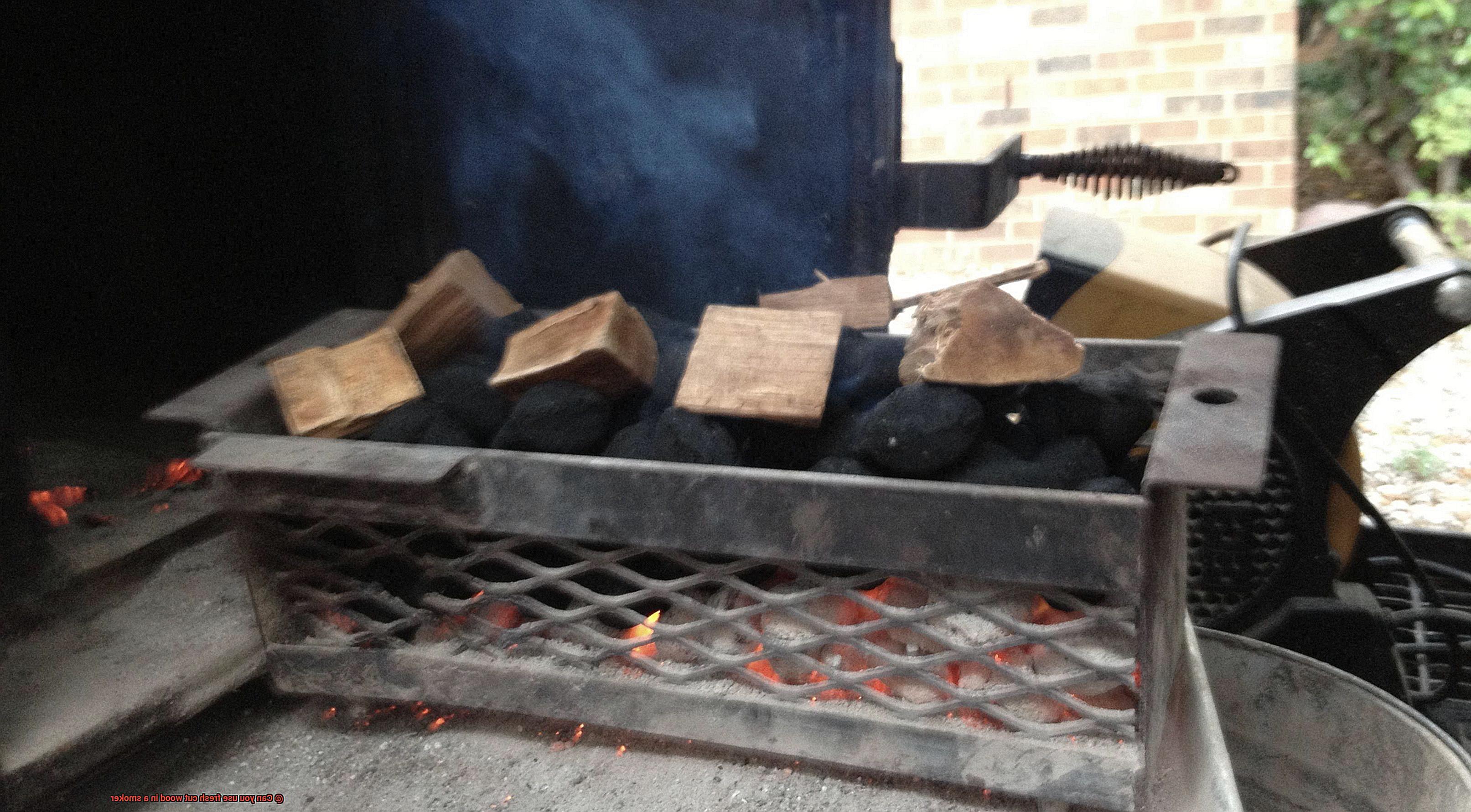
Unseasoned wood may not burn evenly or produce consistent temperatures, resulting in undercooked or overcooked meats. Furthermore, the high moisture content in unseasoned wood can cause it to steam instead of smoke, negatively impacting the flavor of your meats. The flavor is one of the most critical components of smoking meats, and using unseasoned wood can ruin the taste entirely.
In addition to these risks, burning unseasoned wood releases harmful chemicals and pollutants into the air. It produces more particulate matter, which can lead to respiratory problems for those who inhale it. In short, using unseasoned fresh cut wood in your smoker poses several health risks that are easy to avoid.
The solution is simple: only use properly seasoned wood in your smoker. Seasoned wood has been dried out for at least six months to a year, reducing its moisture content and making it safer and more effective for smoking meats. It burns more cleanly and produces a consistent temperature and flavor that will enhance your meats rather than ruin them.
Types of Wood Suitable for Smoking
Smoking meat is an art form that requires a perfect combination of wood and time to achieve the desired flavor. The type of wood you choose will play a crucial role in determining the taste, aroma, and texture of your meat. Let’s take a closer look at the different types of wood suitable for smoking and how they can enhance the flavor of your food.
Hickory
With its bold, smoky flavor, hickory is a popular choice for smoking pork and beef. It’s a versatile wood that can be used for both hot and cold smoking, giving your meat a rich, hearty flavor. The strong aroma of hickory smoke can be overpowering if used in large quantities, so use it sparingly to avoid ruining the taste.
Mesquite
Mesquite is a potent wood that adds an intense, earthy flavor to beef and game meats. It’s not recommended for delicate meats like poultry or fish because its flavor can be too overpowering. Use mesquite in moderation to avoid overwhelming your taste buds.
Fruit woods
If you’re looking for a milder wood to smoke your poultry or fish, fruit woods like apple, cherry, and peach are great options. They have a sweet, fruity flavor that won’t overpower the delicate flavors of these meats. These woods are also popular choices for smoking ham and bacon.
Oak
Oak is a versatile wood that works well with almost any type of meat. It has a mild, smoky flavor that won’t mask the natural flavors of the meat. Oak burns slowly and evenly, making it an excellent choice for longer smoking sessions.
Seasoned Wood
It’s essential to use seasoned wood when smoking meat because fresh cut wood contains too much moisture and can produce an excessive amount of smoke and soot, leaving an unpleasant taste on your food. Seasoned wood has been allowed to dry out naturally, which makes it burn more cleanly and produce a better smoke flavor.
The Best Practices for Storing Fresh Cut Wood
If so, you know that fresh cut wood is a must-have ingredient for achieving that perfect smoky flavor. However, using freshly cut wood right away can lead to unpleasant tastes and aromas. That’s why it’s important to know the best practices for storing fresh cut wood.
First and foremost, you want to store your fresh cut wood in a cool and dry place. Damp storage areas can cause mold growth, which can ruin your wood and impact the taste of your smoked meats. Aim for a temperature between 50-60 degrees Fahrenheit and ensure the storage area is well-ventilated to prevent moisture buildup.
Splitting your fresh cut wood into smaller pieces is also crucial for even drying and preserving its flavor. Large pieces can lead to uneven drying and decay, so grab an axe or saw and get splitting. Additionally, smaller pieces are easier to stack and store.
Covering your stored fresh cut wood with a tarp or plastic sheet is another must-do step. This protects it from rain and direct sunlight, which can dry it out too quickly or make it damp. Neither of these outcomes is desirable when it comes to smoking meat.
Lastly, labeling your stored fresh cut wood is essential for identifying the type of wood and its age. Different woods have varying flavors that can significantly impact the taste of your smoked meats. By labeling the age of the wood, you’ll know when it’s ready for use.
In summary, proper storage of fresh cut wood is crucial to maintain its moisture content and flavor. Here’s a quick recap of the best practices:
- Store in a cool and dry place
- Split into smaller pieces for even drying
- Cover with a tarp or plastic sheet to protect from rain/sunlight
- Label the type of wood and its age
Purchasing Pre-Seasoned Wood from a Supplier
Look no further than purchasing pre-seasoned wood from a reputable supplier. Not only is it convenient, but it can also improve the efficiency and flavor of your smoker.
Before making a purchase, it’s important to ensure that the wood is properly seasoned. This means that it has been thoroughly dried and aged to reduce moisture content. Moisture in the wood can lead to problems when burning and affect the flavor of your smoked meats. Be sure to ask your supplier about their seasoning process and how long they age their wood before it’s ready for sale.
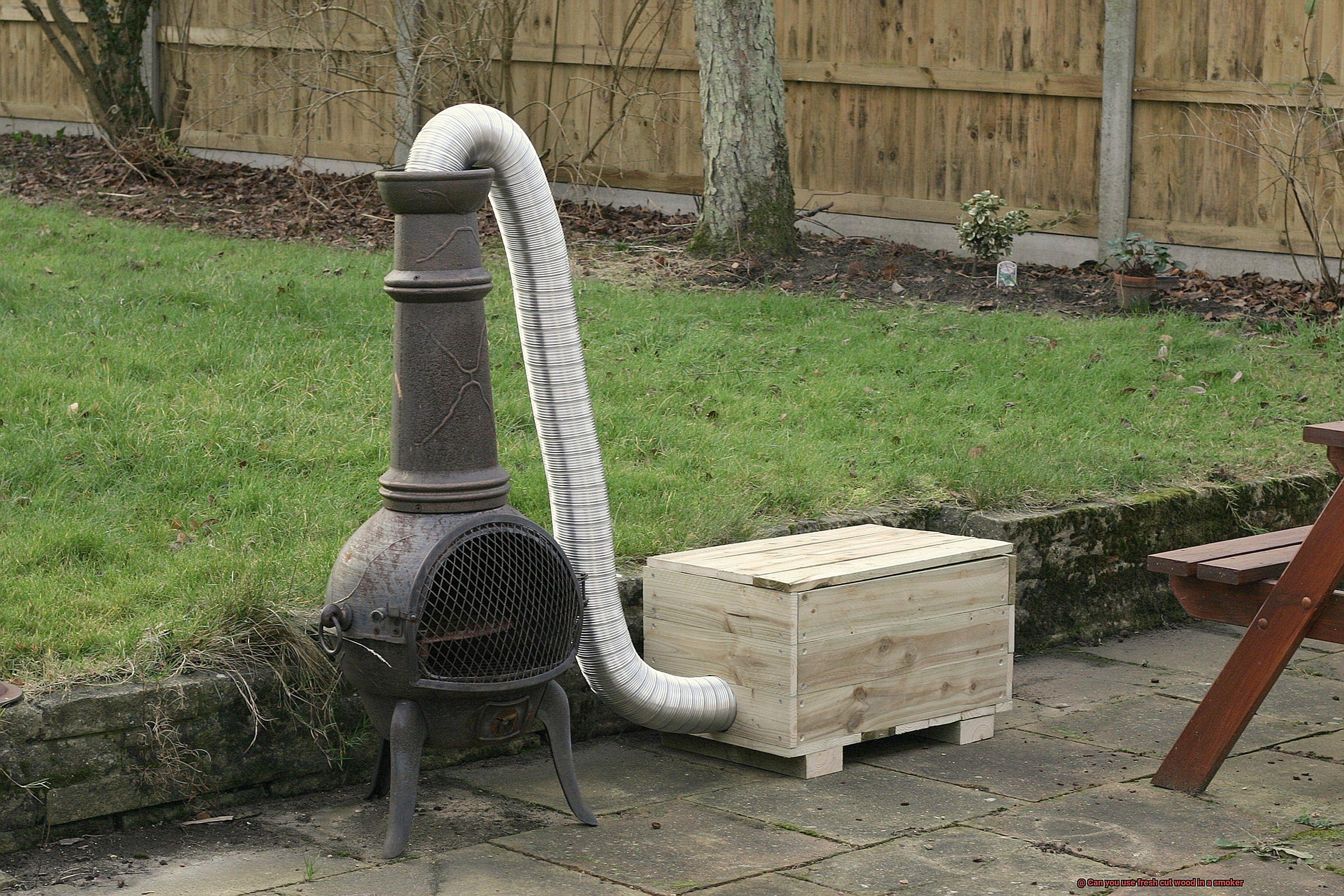
In addition to proper seasoning, the type of wood you choose can greatly impact the flavor of your smoked meats. Popular options include hickory, mesquite, and applewood, each producing its own unique taste. If you’re new to smoking or looking to try something new, don’t be afraid to experiment with different types of wood to find the flavor profile that suits your taste buds.
When it comes to purchasing pre-seasoned wood, it’s crucial to choose a reputable supplier. Look for a supplier who has a good reputation and offers high-quality products. You can read reviews or ask for recommendations from other people who have used their products before.
Tips to Achieve the Desired Flavor Profile with Fresh Cut Wood
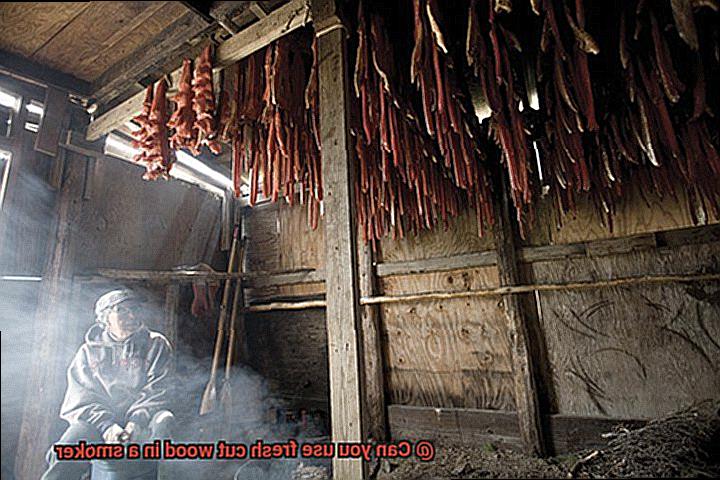
Enhance the flavor profile of your grilled dishes by using fresh cut wood in your smoker. However, it’s essential to know how to properly use it to achieve the desired taste. Below are five tips that can help you achieve that perfect flavor profile:
Season Your Fresh Cut Wood
Proper seasoning is crucial when using fresh cut wood in a smoker. Allow your wood to dry out entirely for at least six months before using it in your smoker. This process removes excess moisture from the wood, which can cause unwanted flavors and even mold growth.
Match Your Wood with Your Meat
Different types of wood produce different flavors and aromas, so it’s important to choose the right type of wood for the meat you’re smoking. For example, fruitwoods such as apple or cherry are great for smoking poultry or pork, while hickory or mesquite are better suited for beef or game meats.
Monitor Your Smoker’s Temperature
Fresh cut wood produces more smoke than aged wood, leading to bitter flavors if not correctly controlled. Keep an eye on your smoker’s temperature and adjust airflow as needed to prevent this issue.
Combine Fresh Cut and Aged Wood
Using a mix of fresh cut and aged wood can balance out strong flavors with mellower ones. Experiment with ratios to find the perfect balance for your desired flavor profile.
Experiment with Different Cuts of Wood
Different parts of the tree produce different flavors, so don’t be afraid to experiment with different cuts of wood when smoking. You might be surprised by the unique and delicious results.
yzP_LTeq100″ >
Conclusion
In conclusion, the allure of using fresh cut wood in a smoker can be strong for outdoor cooking enthusiasts. However, it’s crucial to weigh the benefits and drawbacks before making a final decision. Fresh cut wood is abundant and cost-effective, but it can lead to uneven temperatures, creosote buildup, and unpredictable flavors.
If you choose to use fresh cut wood in your smoker, seasoning is paramount to achieving the desired flavor profile. This entails splitting the wood into smaller pieces and storing it in a dry and well-ventilated area for at least six months. If time is of the essence, kiln drying is also an option.
Using unseasoned fresh cut wood when smoking meat can pose health hazards due to its high moisture content. Additionally, different types of wood impart varying flavors and aromas, so selecting the right type of wood for the meat you’re smoking is essential.
Lastly, proper storage is critical for maintaining moisture content and flavor whether you’re using fresh or pre-cut wood.

